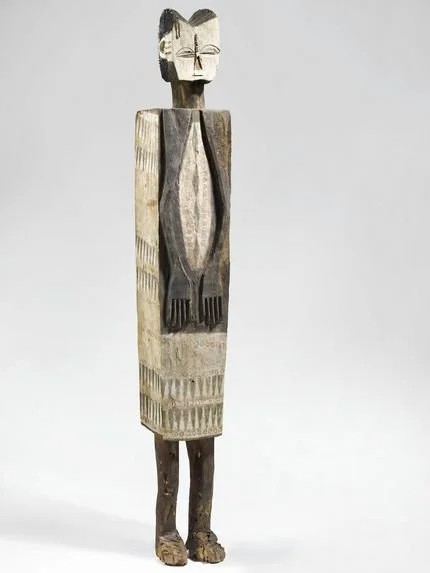Ngata/Nkundu Figure
Ngata/Nkundu Reliquary Figure
Democratic Republic of the Congo
Late 19th century
Wood. Height: 82 in
Price: $1,035,000
Description
The “efomba” reliquary figure of the Ngata people is an example of an extremely rare African funereal form.[1] These bigger-than-life, anthropomorphized figures have been reported to be both coffins for burial and commemorative statues to honor important ancestors.[2] Many have a strictly rectilinear, elongated torso with more naturalistic appendages projecting from this box-like body, and have a large rectangular compartment carved into their backs, suggestive of a space for remains. At nearly 7 feet tall, our imposing male figure is probably the likeness of an important village elder commissioned prior to his death.[3]
The use of these anthropomorphic sarcophagi by the Ngata (or Nkundu) people was centered around Mbandaka, (formerly Coquilleatville), at the confluence of the Ruki and Congo Rivers. Commissioned to carve an efomba, a specialist woodcarver, or bobongo, would secretly fell a tree, anoint it with dog’s blood to clear it of malign spirits, and take it to a sacred clearing to carve and adorn the effigy.[4] Subsequent rituals may have included placing the subject’s bodily remains within the coffin and burying it, (reportedly after breaking the head and legs off the sculpture[5]); while the existence of intact examples suggests the figures were commemorative-- possibly placed inside a burial shrine or in the home--and were not interred.
This unique ritual expression reportedly came to the region as late as 1880 from northern tribal influences, and the last of the bobongo carvers were gone, allegedly between 1940 and 1960. Three prominent examples of efomba are held in museums: 2 at the Royal Museum for Central Africa, in Tervuren, Belgium, collected in 1891; and one, possibly commissioned in 1940 explicitly for display, at the Museum du Quai Branly—Jacques Chirac, in Paris.[6] Another fine example, the “Mestach sarcophagus,” was auctioned by Christie’s in 2012 for E2,697,000, and is presumably still held privately.[7]
The posture of this example--with its head and large ears well forward of the commanding torso-- imparts a sense of authority. Expressively incised facial features also convey a figure of great presence. Slightly ovoid from top to bottom, the overall shape breaks subtly from the precise rectilinear form of most known examples, exhibiting a “rare plastic quality” so highly praised in the figure sold by Christie’s in 2012. Though probably not from the same carver, our figure shares many similar features with that Mestach example: vertically elongated diamond shapes in a grid with alternating blue (indigo) and white (kaolin) colorants, a satisfying horizontal schema to complement the overall verticality of the piece, and a naturalistic carving of the legs, arms and hands. Traces of black vegetal matter on the head suggest the former existence of a hairpiece; that, along with the rectangular chin are features of many Ngata. Heavy patina overall with typical colorants support dating commensurate with other museum pieces. An exceedingly rare, early example of this extraordinary classical form.
Footnotes
[1] Volper, Julien. “Exquisite Vanity: Nkundu Sarcophagi,” Tribal Art: Quarterly Journal of the Art Culture and History of Traditional Peoples and New World Civilizations 15 (4), no. 61 (Autumn 2011): 111.
[2] Felix, Marc Leo. 100 People of Zaire and Their Sculpture: The Handbook : For Collectors, Scholars, and Students (Brussels: Tribal Arts Press, 1987).
[3] Schädler, Karl-Ferdinand. Encyclopedia of African Art and Culture (Munich: Panterra, 2009): 455.
[4] Volper, “Exquisite Vanity,” Tribal Art 2011. 111.
[5] Volper, “Exquisite Vanity,” Tribal Art 2011. 111.
[6] Volper, “Exquisite Vanity,” Tribal Art 2011. 111.
[7] Christie’s. Art Africain et Océanien: Live Auction 3521, 11 December 2012, Paris. Lot 79.
Sarcophagus. Tomba, Nkundu.
Nkundu, Democratic Republic of Congo
Collected by C. Lemaire in 1891, in the Mbandaka region (formerly Coquilhatville)
Wood, pigment, fiber, vegetable resin.
Length: 201 cm
Musée Royal de l'Afrique Centrale.
(Photo: Asselberghs, R. Copyright Musée Royal de l'Afrique Centrale. Republished in: Volper, Julien. “Exquisite Vanity: Nkundu Sarcophagi.” Tribal Art: Quarterly Journal of the Art Culture and History of Traditional Peoples and New World Civilizations 15 (4), no. 61 (Autumn 2011): 108–109.)
Sarcophagus. Efomba.
Nkundu, Democratic Republic of Congo
Wood, pigments
161 x 23 x 22.4 cm
Musée du quai Branly
Inventory Number: 73.1992.0.1
(Photo: Copyright Musée du quai Branly)
[See Also: Photographed in-situ in Africa, 1940, (Published in: Volper, Julien. “Exquisite Vanity: Nkundu Sarcophagi.” Tribal Art: Quarterly Journal of the Art Culture and History of Traditional Peoples and New World Civilizations 15 (4), no. 61 (Autumn 2011): 110.)]
Condition
Major repairs have been made around the neck’s attachment to the body. Extensive termite damage shows on the hollow interior.
Christie’s. Art Africain et Océanien: Live Auction 3521 11 December 2012. Paris: Christie’s, 2012. Lot 79. https://www.christies.com/en/lot/lot-5639194
Felix, Marc Leo. 100 People of Zaire and Their Sculpture: The Handbook : For Collectors, Scholars, and Students. Brussels: Tribal Arts Press, 1987.
LaGamma, Alisa. “Eternal Ancestors: Art of the Central African Reliquary.” Tribal Art: Quarterly Journal of the Art Culture and History of Traditional Peoples and New World Civilizations, no. 46 (Autumn 2007): 72–83.
Musée Royal de l’Afrique Centrale. Masterpieces from Central Africa: The Tervuren Museum. Edited by Gustaaf Verswijver. Munich: Prestel, 1996.
Neyt, François, “Nkundu/Ngata Anthropomorphic Sarcophagus Democratic Republic of Congo, North-West, Mbandaka Region.” In Art Africain et Océanien: Live Auction 3521 in Paris, 11 December 2012, by Christie’s. Lot 79. https://www.christies.com/en/lot/lot-5639194
Schädler, Karl-Ferdinand. Encyclopedia of African Art and Culture. Munich: Panterra, 2009.
Volper, Julien. “Exquisite Vanity: Nkundu Sarcophagi.” Tribal Art: Quarterly Journal of the Art Culture and History of Traditional Peoples and New World Civilizations 15 (4), no. 61 (Autumn 2011): 108–17.



